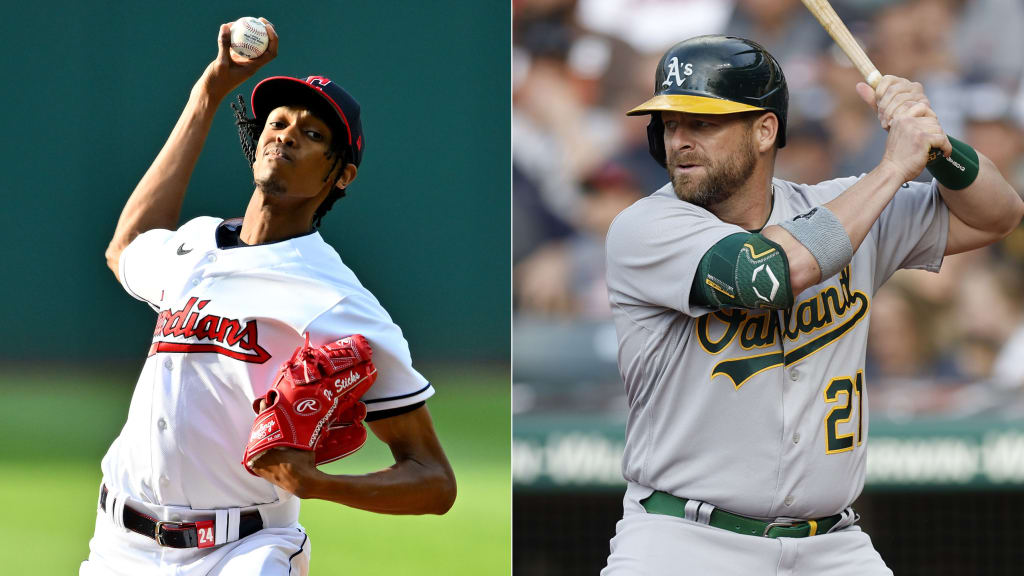GOODYEAR, Ariz. -- It’s June 10, 2022. Stephen Vogt is in the visitors' clubhouse at Progressive Field, preparing for his first time facing some young hurler who has caught a lot of attention. He didn’t know too much about this starter, but he quickly learned why so many people had been talking about him.
The starter just so happened to be Triston McKenzie, a pitcher Vogt would be managing less than two years later.
“I just remember the angle from him,” Vogt recalled. “He’s tall. He’s very upright when he throws, so it’s coming from very, very high on a downward angle and the curveball is so big and sharp. I just remember it not being fun. It’s hard to pick up the ball. It’s hard to see. And before you can really pick it up, it’s by you.”
Fast forward to March 2024. Vogt sat in Cleveland’s media room in Goodyear and was asked what makes McKenzie so difficult to hit from a player’s perspective. After he answered, he took a moment to recall more about that June day.
“I can very vividly remember facing him,” Vogt said. “I don’t remember the exact results. It wasn’t good, I know that.”

Let’s revisit those at-bats, shall we?
“Sure, I like abuse,” Vogt quipped.
First at-bat: First inning
Pitch 1: McKenzie drops a 78.3 mph curveball at the bottom of the zone on the inner half of the plate. Vogt watches it get called for a strike.
McKenzie: "He probably should’ve swung at that pitch."
Vogt: "Curveball, there it is. I foul the next pitch off, maybe?"
Pitch 2: McKenzie comes at Vogt with a 92.7 mph fastball at the top of the zone. Vogt sends an easy fly ball to Steven Kwan in left field.
Vogt: "Nope. Flyout. I mean, that’s two pretty perfect pitches. Curveball for a strike at the bottom and then fastball at the top rail."
McKenzie: "He probably should’ve swung at the first one. I think that’s a bad swing decision by him. Heaters up in the zone is not going to get the job done."
Let’s pause. When the first at-bat between two first-time opponents is limited to two pitches, what does each side learn about the other?
McKenzie: "Rewatching this, looking at how his body moves as he swings. That [second] pitch is kind of like middle, middle away, but top of the zone. But I see his body kind of moving away, which is why I also think he probably should’ve swung at the first one. I think that whole next at-bat I’m probably going away from him with heaters, sliders, whatever I throw.”
Vogt: "The curveball, I’m like, 'OK, that was right at the bottom,' so I saw where it started. So now I know if I see the curveball starting lower, it’ll be a ball. Then he hit the top rail on the fastball so I know I don’t want to go any higher than that, if that makes sense. You get your bearings on where the bottom was with that curveball and where the top was with the fastball."
Second at-bat: Fourth inning
Pitch 1: McKenzie throws an 86.7 mph slider at the top of the zone, on the outer half of the plate. Vogt watches it for a strike.
Vogt: "Just throw me something over the middle, Triston!"
McKenzie: "Outer lane to play off that same heater. Hopefully, I get a swing there. I’m probably going to throw a fastball [next]."
Pitch 2: McKenzie sticks with his offspeed, throwing a 78.6 mph curveball that was slightly above the strike zone. However, home-plate umpire Bruce Dreckman called it a strike.
Vogt: "Oh, let’s go, Bruce. That’s not fair. I’m sure I gave my reaction here. I said, ‘Ah, man, that’s up.’"
McKenzie: "Oh, a curveball! … Oh, gimme that! Oh, yes! [laughs] I can tell why he’s unhappy. That’s a ball. That’s a ball and a half, actually."
Let’s pause again. How does it change a pitcher’s mind-set when he steals a strike like that?
McKenzie: “It definitely boosts my mood. … We know what’s a strike from repetition, from throwing bullpens, from hitting in the cage, from whatever it is. We have a good idea of what’s a strike and what’s not. So when you get a pitch like that, it can change the whole course of the at-bat. One, with the count, if it goes 0-1 to 0-2 or 0-1 to 1-1, as well as just like mentally where that puts you in terms of, ‘Do you have to be defensive? Can you be more aggressive? Can you throw a pitch that maybe you wouldn’t throw because you’re ahead?’ Stuff like that.”
Pitch 3: McKenzie throws a 79.0 mph curveball in the dirt. Vogt takes the ball. The count is 1-2.
McKenzie: "That’s where I wanted the first one. That’s a good take. I’m guessing next will be a heater up."
Vogt: "I picked up the curveball early and saw it. It started lower than the other ones, so you’re able to take it."
Pitch 4: Vogt fights off a 94.1 mph fastball on the hands and serves a slow chopper down the third-base line in foul territory.
McKenzie: "Heater up. That’s a bad pitch by me. That’s got to be a ball, ball [if he doesn’t swing]."
Vogt: "I just got beat by a fastball, but you stay alive with two strikes."
Pitch 5: Vogt spoils another 94.5 mph heater at the top of the zone to stay alive.
Vogt: “Good fight. Good fight. Good fight!”
McKenzie: “95 [mph] out of the kid! Good pitch. Curveball down, slider off of that. Definitely an offspeed pitch [coming].”
Pitch 6: McKenzie’s 81.6 mph curveball plummets into the dirt as Vogt swings and misses. Catcher Austin Hedges picks up the ball and flicks it to first base to record the out.
McKenzie: "Curveball down. Oh, and I love the nonchalance by Hedges there, too."
Vogt: "That was filthy."
Third at-bat: sixth inning
Pitch 1: McKenzie goes back to the curveball, dropping it over the outer half of the plate in the middle of the zone at 78.7 mph.
Vogt: “When all you can hit is a fastball, you see a lot of offspeed.”
McKenzie: “We started him out slow, just trying to get him off the heater because he’s putting good swings on the fastball. Even though he’s not necessarily making good contact, he’s putting good swings on it. So that’s something that we’re paying attention to. And probably why out of nine pitches, he’s seen three fastballs.”
Pitch 2: Vogt takes his chances at a 92.6 mph heater on the outside of the plate at the top of the zone. This was back when defensive shifts were legal, so third baseman José Ramírez was in shortstop territory, fielded the easy ground ball and recorded the out.
Vogt: “Oh, where you playing me Joséy?”
McKenzie: “Again, but like outer lane, staying with that same approach.”
Vogt never faced McKenzie again after that day. He ended his career going 0-for-3 against Cleveland’s hurler. His takeaway?
Vogt: “He pitched me really well that day. There was nothing in the middle of the zone. Nothing on the inner half. The only pitch I got on the inner half was off, in, on a 1-2 count. That’s obviously Hedgey doing his homework. That’s Triston being able to execute. At that point in my career, I didn’t have too many hot zones left, but they avoided all of my hot zones. So you know where you want to stay from, and he executed really well.”
Vogt sat back in his chair, relieved he didn’t have to watch himself any longer.
Vogt, sarcastically: “Thanks for showing me that. This is fun. Can we watch highlights sometime, too?”
